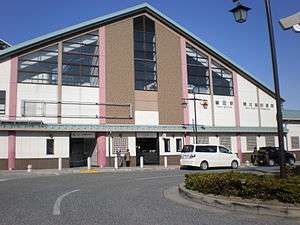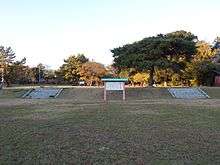Tōtōmi Kokubun-ji
| Tōtōmi Kokubun-ji ato 遠江国分寺跡 | |
|---|---|
 Tōtōmi Kokubun temple | |
| General information | |
| Type | Shichidō garan |
| Address | 3220-1, Mitsuke, Iwata city, Shizuoka, Japan |
| Town or city | Iwata, Shizuoka |
| Country | Japan |
| Coordinates | 34°43′10″N 137°51′05″E / 34.71948542°N 137.85137974°E |
| Designations | Monument |
The Tōtōmi Kokubun temple (遠江国分寺跡 Tōtōmi Kokubun-ji ato) is situated in the Iwata city of Shizuoka Prefecture. In Japan during Nara period, lot of provincial temples and nunneries were built across the country. This temple was built on the Emperor Shoumu's orders in 741. Shōmu (701 – 756?) decreed both a kokubun-ji for monks and a kokubunni-ji (国分尼寺?) for nuns to be established in each province.
When this temple was excavated in 1951, it was discovered that the temple buildings were in the "Shichidō garan" formation, a type of formation similar to Todaiji-temple in Nara. It was designated as a special historic site of the Japan in 1962.
The recent excavations estimate that the site's area was about 180 meters long from east to west and about 253 meters-long from North to South, and that it existed from the later half of the 10th century to the 11th century. In the middle ages, number of Kokubun-ji temples declined, but a small temple was built in one corner of Tōtōmi Kokubun temple.
Now the site is preserved as a historical site park and is a popular place to relax. The Iwata station's building is reminiscent of Totomi Kokubunji temple.

Construction details
This kokubun-ji was built having the configuration of the main temple hall surrounded with the seven storied pagoda,an auditorium, corridors and the middle gate. The auditorium was located on the north side, the middle gate was located on the south side, and the corridor was around main hall. It is thought that related facilities were scattered around the temple's site.

The roof tiles used for the main temple and the nunnery were baked in a kiln that was mainly located in Kakegawa city (former Osuka Town). During the restoration, the roof tiles were baked in Iwata. The traces of foundation stones of the seven storied pagoda were discovered during the excavation. The construction and maintenance required huge labor and expenses.
See also
- Glossary of Japanese Buddhism
- Provincial temple
- Nara period
- List of Historic Sites of Japan (Shizuoka)
References
- 遠江国分寺跡, Iwata city office website(Japanese) Totomi Kokubunji temple
- Totomi Kokubunji temple [1]